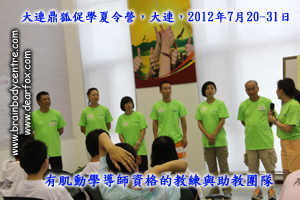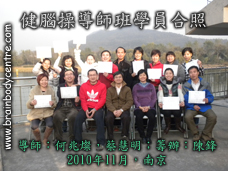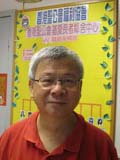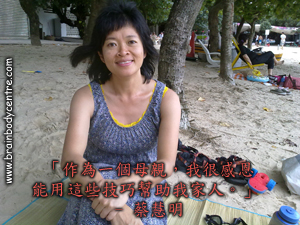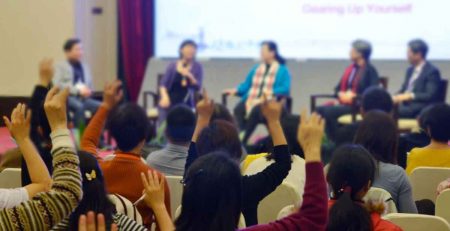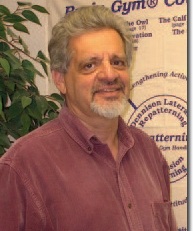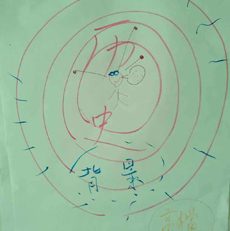What did children learn at the Dalian Dearfox Learning Enhancement Camp?
Bao Peng Tao (Dalian)
Jul 13, 2012
Next Learning Enhancement Camp in Dalian. mid-July 2013. Watch for our announcement later
In the 12 days at the Dalian Dearfox Learning Enhancement Summer Camp, children were immersed in lightheartedness, happiness and joy; more importantly, they noticed themselves more and experienced great improvement and change! With the three parts of the Camp’s course (which are Move to Learn, Double Doodle Play and Positive Learning Beliefs) combined, children were able to receive various suitable stimuli, both psychologically (including understanding and building positive beliefs, changing their way of seeing things and themselves, raising self-esteem, handling matters more flexibly, being more creative and so on) and physically (including a clear understanding of their own current capability; a better coordination between the brain’s back and front, left and right, top and bottom; an increase of sensory sensitivity; a better balance of the body; a more acute control of the brain towards different muscles of the body; an accurate feeling of the level of security; and overcoming or eliminating developmental disorders). As such, the developmental process of their body and mind was optimized.
On the surface, there wasn’t much improvement directed towards learning the textbook knowledge taught in school! That is because “learning” in the Camp was learning in a broad sense, including the whole process of the sensory input of new information (such as seeing and listening), thinking and processing, storing and retrieving memory, and finally outputting through movement (such as speaking, body language, writing, typing and so on). In reality, as a living human being, from the moment life began, to being born, to growing up, the body has its own sequence of development (such as the integration of reflexes, locomotion, conceptualization and so on). Only when this sequence of development is thoroughly completed according to nature’s design can a human show excellent capability in various areas, also known as fully actualizing one’s potential. However, when any area is not completely developed, it will disturb the sequence of development afterwards, slowing down and even stopping the development in certain areas. Children will then show abnormal behavior, such as sucking on their hands, forgetting what they just heard, and not being able to integrate into groups and participate in group activities.
To make an analogy, the body’s process of development is like going to elementary school: first grade, second grade, third grade� only after all grades are passed in elementary school can one enter middle and high school. However, if the scores in a certain grade are not enough, a child cannot move on and has to stay behind and repeat the year, until all scores have passed. Then he can move on to the next grade.
This lets us understand that, if a child’s fundamental physical and psychological development is not done properly, he will be limited in areas such as academic studies, social interactions, controlling emotions, taking up challenges, thinking through problems, dealing with life and people, facing failures, and self-esteem. On the surface it may look like the child is not active enough, is mischievous and does not take things seriously, but actually it is a problem of the body and mind’s development.
The Camp’s goal was to train children through Move to Learn, Double Doodle Play and experiencing Positive Learning Beliefs, so that children may revise the parts that they needed training and relearning in the developmental sequence. A child may be stuck at a certain point; through these activities, he can develop again and develop physical and mental abilities closer to his current age. Through the recovery and improvement of these fundamental abilities, the children’s capability at school is stabilized and strengthened. Therefore, the Camp did “foundation works” and optimized children’s learning from the base.
In the following, the training directions involved in the courses will be listed. On the one hand, this is to let parents know more specifically the Camp’s course of events, and how this changed the children; on the other hand, this allows parents to see more sides of the children and understand the concept and operation of learning as a whole, so they may eventually better support their children:
Coordination between left and right brain (the big picture and details):
The left and right hemispheres of the brain are respectively responsible for the two sides of the body, creative and rational thinking, as well as looking at the big picture and details. This part of the training allows children to better understand the meaning of written words; increase creativity; to better actualize their thoughts; and also improve the agility of both sides of the body, increase children’s understanding of matters as a whole, and being able to consider both the big picture and the details;
Coordination between front and back brain (sense of security):
The front of the brain is the prefrontal cortex, responsible for making decisions. The signals collected by the body are first delivered by the brain stem located at the back of the brain. When the brain stem believes that the survival of the body is threatened, it enters into defense mode and tension sets in. As the amount of blood flowing through the prefrontal cortex reduces, it slows down or even stops functioning; humans then cannot think of solutions and will show a limit in capability. This part of the training facilitates children’s proper understanding of the dangers of the outer world, reduces the frequency of entering into defense mode, and eliminates internal muscle tension, thus freeing up the frontal cortex for more constructive thinking. As such, children can adapt and show more capability, and increase their self-esteem.
Coordination between top and bottom brain (emotion control, organizational skills):
The top and bottom of the brain refer to the neocortex and the limbic system respectively. The signals received by the body pass through the limbic system, which is responsible for emotions, before reaching the neocortex. When the limbic system understands the signals to mean that there is danger in its survival in the society, the prefrontal cortex slows down and even stops working, and the person appears to be controlled by his emotions. This part of the training rebuilds the limbic system’s identification of signals, provides a clearer understanding of one’s emotions, and works together with the neocortex to better control these emotions. As such, one can better organize his relationships in the society, and this serves a basic function in his social interactions.
Sense of balance:
A sense of balance is one of the most basic senses that allow humans to move around in space. If a person cannot balance, he cannot do anything; he can hardly move, let alone study. If we have never experienced a better sense of balance in our course of development, we will naturally assume our current state is a state of balance. This part of the training allows children to feel a better balance, improves their response to the sense of balance, and strengthens their bodies understanding of balance, in order to build a firmer foundation for learning.
Sense of hearing:
We can all hear noises, but hearing and listening are two different concepts. Listening refers to remembering, understanding and being able to recite and apply; if something is only heard, it can be forgotten right afterwards. This part of the training allows children to clearly distinguish tone, volume, location and distance, and trains them to listen in a relaxed state, which facilitates both foreign language learning and auditory memorization.
Sense of seeing:
We can see as soon as we open our eyes, but the ability to see things completely, and to quickly find what we want to see and focus on it accurately, differs from person to person, which is why we have the phrase “turning a blind eye.” This part of the training trains the eye to quickly focus and identify colors, allows the signals received through the eyes to better and more quickly reach the brain, and so triggers the brain to think and associate, in order to more smoothly interpret the signals from the eyes. In terms of learning, children can read more smoothly and reduce the frequency of missing words when copying and reading, leading to a better handling of visual information.
Sense of touch:
Different parts of our body transfer signals to the brain, and the brain analyses the signals in order to control the responding muscles to make a reaction. Better input, analysis, understanding and output of signals received through the sense of touch can help children better control tools, including paper and pens, books, keyboards, joysticks, steering wheels, chopsticks, rackets and balls, so that children may perform more outstandingly in both the classroom and on the playground. Parents may think how their children perform on the playground has no direction relationship with academic studies, but in reality there is an important indirect correlation between the two. If a student is laughed at or even ostracized because he is not quick on the playground, this may affect his school and social life, and cause him to resist going to school.
Sense of movement: Holding a pen and writing, reading, looking up at the blackboard, sitting in front of the desk, talking, gesturing and so on, how do we know we’ve utilized the force and the muscles that we should? When our body goes from staying still to moving, it must go back to being still, so when we reach out for a cup or to catch a ball, swing a pen or a racket, or make an expression with our face, how do we know when to start and stop? These techniques that involved the sense of movement directly affects whether a child articulates or mumbles, whether he is slow or agile, and whether he has rich or weird expressions. Of course, it also affects learning, both directly and indirectly. In a competition, because of nervousness, some children will grit their teeth, make fists and tighten their shoulders, where only movement in the legs is needed! These so-called connected motions waste the body’s energy without reason, causing children to be tired and tense internally. Therefore, knowing when to relax and when to apply force, stopping once something is achieved and keep moving when it isn’t, allow children to economize their energy and use more energy on learning.
Coordination of muscle control: In terms of mechanics, in order to complete the action of moving a pen in the hand, the arm must transfer the action from the fingertip (small muscles) all the way up, through the upper arm (large muscles), eventually reaching the abdomen (core muscles); these are the three muscles that coordinate in the process of writing. When a student look up to read the writing on the blackboard, and then look down to read the writing on the book, then back again at the blackboard, this kind of repetitive refocusing of the eyeball requires the fine motor coordination of the eye’s muscles. As a teacher paces back and forth as she teaches, or as classmates sitting at different locations speak, there is naturally a difference in volume to the student sitting at the same place. The coordination of the ossicle muscles, located behind the eardrum and responsible for controlling the amount of stimulus that enters the auditory sensor, directly affects the student’s effectiveness of listening during the lesson. This part of the training helps the brain to more accurately control core muscles, large muscles and small muscles, so that they can be more coordinated in movement.
Building social skills: Besides having the foundation of learning within the body, children must realize their position within a group and know how to interact with others, as well as how others and themselves affect one another, or even how to not affect one another. In the Camp, not only were the children interacting with others and practicing their social skills all the time, their interactions also took place under the observation of registered Kinesiology instructors with a lot of case study experiences, allowing them to receive immediate and professional feedback. As such, children who were at a loss could learn to achieve their goals by continually trying out new methods; children who did not like to talk could learn to express themselves actively; children with a strong personality within the group could learn to listen to others’ opinions; children lacking self-confidence could learn to acknowledge their gradual improvement. It was the building up of positive social habits.
Positive learning attitude: When thinking about learning, children often associate it with heaviness, tension, and unhappiness! In the Camp, through various competitive and cooperative games, children first planned, then put the plan into practice, and noticed bits and pieces during the process; they continually fine-tuned their actions to increase their chance of succeeding, and learned while having fun. As such, children realized that learning could be a fun game, could be vibrant and interesting, and could be done happily. Naturally, their attitude towards learning became more positive and they took actions more actively.
All these mentioned above are things children could take away from the Camp. Another feature is, during the course, the coaches were particular about letting the children experience their true self, so all activities were done or led by the children themselves, and they also bore the consequences. The true extent of their thinking and problem-solving abilities thus emerged naturally. With such solid foundation, children could truly improve and progress!
In terms of psychological enhancement, children learned to adjust their psychological state through beliefs, the subconscious and the NLP method.
Knowing and changing beliefs
Beliefs are things within everyone that they firmly believe to be true. Psychology says that humans will eventually become a product of their beliefs. Beliefs have a huge impact on a person, even until life and death. Therefore, finding out the restricting beliefs of oneself and trying one’s best to break them can be considered a person’s reaffirmation of himself from deep within his heart! As these beliefs limit children’s exertion of their capability, this part of the training helps children to find their own restrictive beliefs and making modifications, so that their lives can be more directed and powerful.
Power of the subconscious
We do not fully understand the effect the subconscious has on us, but if there are things that our subconscious is unwilling to do, we can’t do it, and even if we did it, there would be an aftermath. We let children understand how incredible the subconscious is, so that when they set goals to do something they can have the support of the subconscious. This internal integration allows them to more confidently and powerfully obtain results in joy.
Changing of metaphors
A metaphor sees things in the way of an analogy; it is an expression of a belief system. If children makes a metaphor between important matters and things they do not enjoy, it shows from another angle how they see and handle these matters. Through changing the way we see and think things and make metaphors, we can change our internal evaluation system. As children learn to change their metaphors, they will have internal improvement in learning, relationships and themselves, and show a difference in effectiveness, attitude and result.
During the course, three instructors, six experienced coaches and six casework teachers from Dearfox accompanied the children the whole way. We acknowledged every little bit of improvement of the children verbally and by leaving them notes, as no matter the outcome was a success or a failure, it was all a learning process. We saw the internal light and strength within the children. All that we did was so that they could find their own internal treasure.
We sincerely hope that parents can open their hearts and totally accept and look upon their children, as each child is different. Only by witnessing their daily growth and improvement can a happy, confident, bright and powerful child be brought up. The Camp gave the children more than just physical and psychological growth. As the children share their learning, joy and experience with their parents at the Camp, we hope that parents can be inspired to rethink and coordinate the education at home and the education at school. This way, the quality of the children’s overall education can increase and can better suit the children’s needs.
The foundation is the most important; only when it is strong and firm can stable academic and other achievements be built atop.

